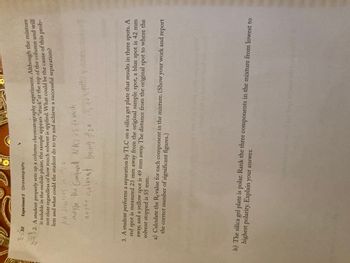
Chemistry
10th Edition
ISBN: 9781305957404
Author: Steven S. Zumdahl, Susan A. Zumdahl, Donald J. DeCoste
Publisher: Cengage Learning
expand_more
expand_more
format_list_bulleted
Question

Transcribed Image Text:Experiment 2 Chromatography
2. A student properly sets up a column chromatography experiment. Although the mixture
is soluble in the mobile phase, the sample appears "stuck" at the top of the column and will
not elute regardless of how much solvent is applied. What could be the cause of this prob-
lem and what could the student do to try and achieve a successful separation?
NA disolves in H₂0
Salt NA
wote H
$22
ер
maybe
e Compound NASI is to much."
anthe solvent being 120
being Alzo is to little v
3. A student performs a separation by TLC on a silica get plate that results in three spots. A
red spot is measured 23 mm away from the original sample spot, a blue spot is 42 mm
away, and a yellow spot is 49 mm away. The distance from the original spot to where the
solvent stopped is 55 mm.
a) Calculate the Re value for each component in the mixture. (Show your work and report
the correct number of significant figures.)
highest polarity. Explain your answer.
b) The silica gel plate is polar. Rank the three components in the mixture from lowest to
d
Expert Solution
This question has been solved!
Explore an expertly crafted, step-by-step solution for a thorough understanding of key concepts.
This is a popular solution
Trending nowThis is a popular solution!
Step by stepSolved in 3 steps with 2 images

Knowledge Booster
Learn more about
Need a deep-dive on the concept behind this application? Look no further. Learn more about this topic, chemistry and related others by exploring similar questions and additional content below.Similar questions
- 10) A pure sample of an oxide of sulfur (S?O?) contains 40% sulfur by mass. The molar mass of the molecular formula of the compound is 160.12 g/mol. Determine the molecular formula of the compound. Show all work.arrow_forwardA chemical analysis yields masses of Zn that are higher by 2 mg compared to the expected value. Calculate the percentage relative error if the true mass of Zn in the sample is 125 mg. O 100.4% O 0.8% 98.4% O 1.6%arrow_forwardWhat volume (in mL) of 15.921 ppt K+ (39.0983), with a density of 1.01 is needed to provide 8.31 x10-4 g of potassium ion? Show all needed work on your scratch paper.arrow_forward
- 1. How many grams of Cu+ are present in 2.20 grams of copper(I) chromate? grams Cu+.2. How many grams of copper(I) chromate contain 3.24 grams of Cu+? grams copper(I) chromate.arrow_forwardPls answer this for me. Thank you so mucharrow_forwardThe following volumes of 0.000300 M SCN are diluted to 15.00 mL. Determine the concentration of SCN in each sample after dilution. These values will be used during the experiment. To enter exponential values, use the format 1.0e-5. Sample 0.000300 M SCN (mL) [SCN'] (M) 1 1.50 3.50 7.00 4 10.00 3.arrow_forward
- Imole 1,5g Cu 504,3 X Imole ('u 5 0415H20 = Moles of anhydride used. (Show calculations) = Cu Soy • 5H20(s) A ('u 504 (5) + 5H20 (9) Hydrate » anhydride Moles of H₂O of hydration (Show calculations)= Ratio of moles of water to moles of anhydride (Show calculations.) = Molarmass = (to correct sig. figs. - do not round yet) Based on your data, what is the empirical formula of your hydrate (round your ratio to the closest whole number)? Use the Argumentation Framework (see inside front cover) (Claim- Evidence- Justification) to justify your answer. 147 S 112 52arrow_forwardCalculate the percent error between your average experimental value and theoretical value for the mass percent of oxygen in KClO3. Show your work clearly. TV = 39.165% EV = 40.767%arrow_forwardPlease don't provide handwritten solutionarrow_forward
arrow_back_ios
SEE MORE QUESTIONS
arrow_forward_ios
Recommended textbooks for you
 ChemistryChemistryISBN:9781305957404Author:Steven S. Zumdahl, Susan A. Zumdahl, Donald J. DeCostePublisher:Cengage Learning
ChemistryChemistryISBN:9781305957404Author:Steven S. Zumdahl, Susan A. Zumdahl, Donald J. DeCostePublisher:Cengage Learning ChemistryChemistryISBN:9781259911156Author:Raymond Chang Dr., Jason Overby ProfessorPublisher:McGraw-Hill Education
ChemistryChemistryISBN:9781259911156Author:Raymond Chang Dr., Jason Overby ProfessorPublisher:McGraw-Hill Education Principles of Instrumental AnalysisChemistryISBN:9781305577213Author:Douglas A. Skoog, F. James Holler, Stanley R. CrouchPublisher:Cengage Learning
Principles of Instrumental AnalysisChemistryISBN:9781305577213Author:Douglas A. Skoog, F. James Holler, Stanley R. CrouchPublisher:Cengage Learning Organic ChemistryChemistryISBN:9780078021558Author:Janice Gorzynski Smith Dr.Publisher:McGraw-Hill Education
Organic ChemistryChemistryISBN:9780078021558Author:Janice Gorzynski Smith Dr.Publisher:McGraw-Hill Education Chemistry: Principles and ReactionsChemistryISBN:9781305079373Author:William L. Masterton, Cecile N. HurleyPublisher:Cengage Learning
Chemistry: Principles and ReactionsChemistryISBN:9781305079373Author:William L. Masterton, Cecile N. HurleyPublisher:Cengage Learning Elementary Principles of Chemical Processes, Bind...ChemistryISBN:9781118431221Author:Richard M. Felder, Ronald W. Rousseau, Lisa G. BullardPublisher:WILEY
Elementary Principles of Chemical Processes, Bind...ChemistryISBN:9781118431221Author:Richard M. Felder, Ronald W. Rousseau, Lisa G. BullardPublisher:WILEY

Chemistry
Chemistry
ISBN:9781305957404
Author:Steven S. Zumdahl, Susan A. Zumdahl, Donald J. DeCoste
Publisher:Cengage Learning

Chemistry
Chemistry
ISBN:9781259911156
Author:Raymond Chang Dr., Jason Overby Professor
Publisher:McGraw-Hill Education

Principles of Instrumental Analysis
Chemistry
ISBN:9781305577213
Author:Douglas A. Skoog, F. James Holler, Stanley R. Crouch
Publisher:Cengage Learning

Organic Chemistry
Chemistry
ISBN:9780078021558
Author:Janice Gorzynski Smith Dr.
Publisher:McGraw-Hill Education

Chemistry: Principles and Reactions
Chemistry
ISBN:9781305079373
Author:William L. Masterton, Cecile N. Hurley
Publisher:Cengage Learning

Elementary Principles of Chemical Processes, Bind...
Chemistry
ISBN:9781118431221
Author:Richard M. Felder, Ronald W. Rousseau, Lisa G. Bullard
Publisher:WILEY